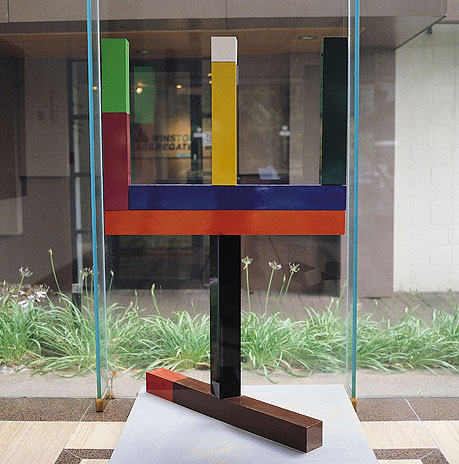PAREKŌWHAI, Michael;
Atarangi
1990
Lacquer on wood
1600 x 1000 x 100mm

This is one of a series of related but different works called Atarangi. Megan Tamati-Quennell notes, ‘The title Atarangi, which in literal translation means ‘morning sky’, is defined more generally as ‘new beginnings’.’[1] This particular sculpture formed part of the 1995 touring exhibition Nervous Systems, which explored tensions between conflicting patterns of identity in Aotearoa.
Robert Leonard has noted, ‘With minimal form and uninflected surfaces, Atarangi might be thought to side with American neo geo. A set of ten huge blocks—magnified versions of the Cuisenaire rods introduced into New Zealand schools in the late 1960s to teach basic maths—have been stacked to form the word ‘HE’, tipped on its side.’[2] The work can also be read as a stylised figure with arms raised, reminiscent of forms in customary Māori art.
Although originally used to teach mathematics, Cuisenaire rods were later incorporated into Te Ataarangi, a programme for teaching te reo Māori. In this context, they serve as props around which conversations are conducted. The rods can thus be understood as a recuperation of Pākehā educational devices and an assertion of Māori culture and strength.
This sculpture poses a number of puzzles. Is the suggestion of a figure participating in a haka an indication that Māori identity is triumphant? Is the word ‘he’ to be read as the indefinite article (‘a/an’) in Māori or the singular, masculine, third-person pronoun in English? Does the turning of the word on to its side imply that Pākehā education has been an emasculation for Māori?
While each of these meanings is plausible, none is clearly preferable. In relishing such interpretative pluralities, Parekōwhai simultaneously asserts and displaces his identity, expressing a sense of ambiguity that was a significant issue in the 1990s for a number of younger artists of Māori and Pākehā heritage.
[1] Megan Tamati-Quennell, ‘Atarangi’, Museum of New Zealand Te Papa Tongarewa, 2018, https://collections.tepapa.govt.nz/object/774315.
[2] Robert Leonard, ‘Michael Parekowhai: Against Purity’, Art New Zealand 59 (Winter 1991), https://robertleonard.org/michael-parekowhai-against-purity/.